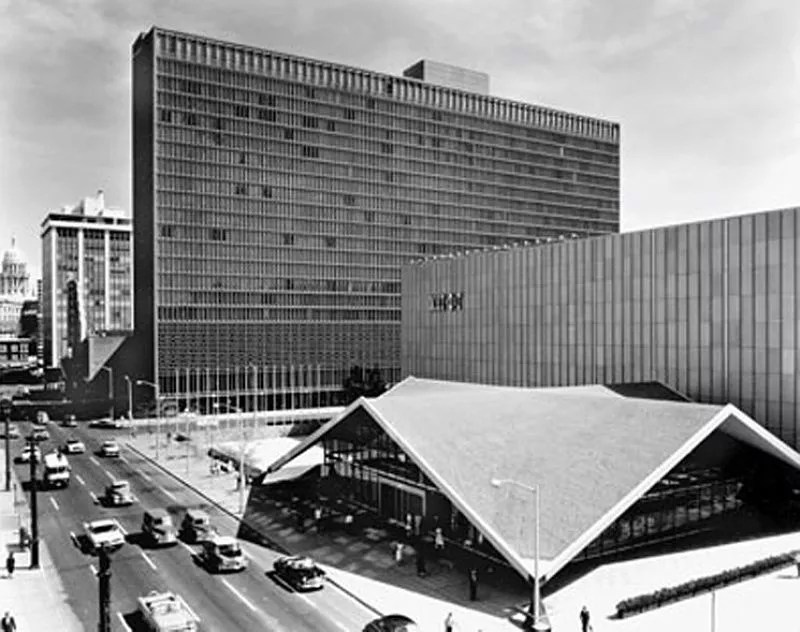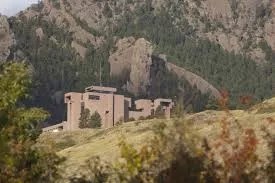
Courtesy of Roach Photos

Audio By Carbonatix
Master architect I.M. Pei passed away on May 16 at the age of 102. His work has been lauded around the world, but Denver has treated his legacy as if it were nothing more than trash.
Back in the 1950s and ’60s, Colorado began showing up on the international architectural map, thanks to several local projects – chief among them three designed by then-emerging Pei: the Mile High Center and Zeckendorf Plaza in downtown Denver, and the National Center for Atmospheric Research, just south of Boulder.
The only one of the three that remains unmolested today is NCAR, and it looks as good as it ever did, rising in the foreground of an iconic view of the Flatirons. Meanwhile, the two Denver projects dating from that period both suffered partial demolition and extensive and insensitive remodeling.

Still standing outside Boulder.
NCAR
Pei’s original Mile High Center included a minimalist tower (still standing at 17th Avenue and Broadway), a courtyard that adjusted to the hilly grade of the site via stairs following a waterfall that dumped into a pond stocked with trout and, up the hill at the Lincoln Street end of the property, a low pavilion with glass walls and a parabolic arched roof done in stainless steel. It was in absolutely perfect condition when it was destroyed in the ’80s by an atrium addition that called for the removal of the pavilion and plaza while absurdly climbing the walls of the tower. This “renovation” was part of Phillip Johnson’s otherwise masterful “Cash Register” building on the next block east, but made no real contribution to that. The added atrium was a stupid egocentric move on Johnson’s part, because he knew exactly what he was doing, including making the Pei tower look too short.
Imagine if a more sensitive vision had led to our having a choice early Pei adjacent to a stunning late Johnson, instead of what’s there now.
When the Mile High Center was vandalized, no one was thinking about historic preservation applying to modern buildings. But that was not the case when Zeckendorf Plaza was destroyed in the mid-1990s.
Pei designed the circa 1960 Zeckendorf Plaza as a pavilion in the shape of a pyramidal hyperbolic paraboloid (anticipating the pyramid that he would create at the Louvre) that was enclosed by glass-curtain walls; it provided the entrance to a boxy department store. Across Court Street, a heavily figured cast-concrete tower housing a hotel was linked to the store by a skybridge and, more significantly, by a forecourt complete with an ice skating rink in the winter.
The Denver Urban Renewal Authority and the Wellington Webb administration, which subsidized the hotel project that destroyed Zeckendorf Plaza, understood that it was a beloved complex, as well as the single-most important work of mid-century modern architecture downtown. When a major effort was mounted to save it, the complex passed the Denver Landmark Preservation Commission unanimously, but it only garnered two votes on Denver City Council, thus dooming the Pei masterpiece. It was one of the most tragic civic failures I’ve ever witnessed in this town.
As a result, the hyperbolic paraboloid was demolished, the department store was clad in gaudy new materials, and the plaza was turned into a driveway. The hotel still stands, though its ground floor and roof line have been molested and its renowned lobby gutted. (It was designed by Alexander Girard, a star of the current Serious Play at the Denver Art Museum.)
The failure to save Zeckendorf Plaza marked the informal end of historic preservation in Denver, because, hey, if the city’s landmark process can’t save a Pei, what can it save?
Interestingly Pei came back to Colorado in the 1980s when his firm designed the 16th Street Mall – which, of course, is also set to be redone, which means another Pei creation could soon be erased.
We can imagine Denver as a great city; we just can’t make it happen.